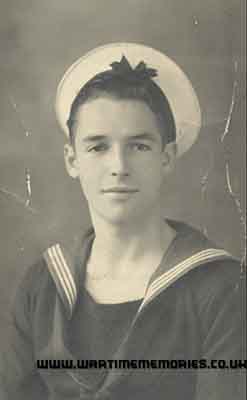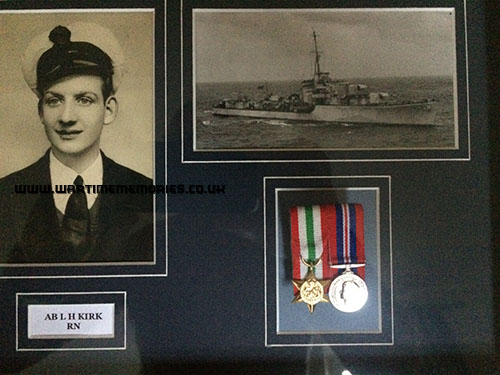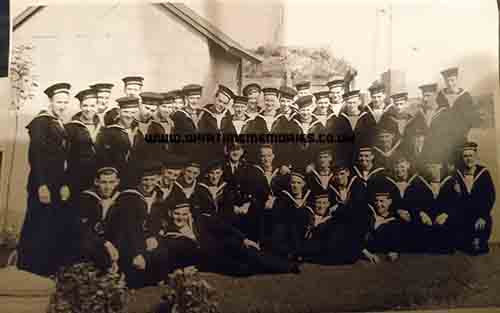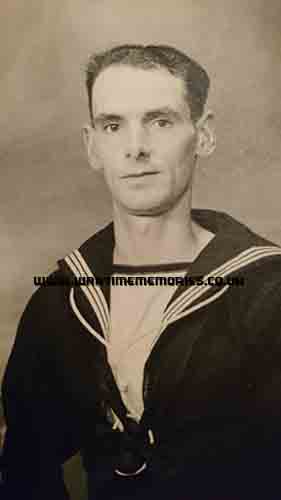|
|
|
HMS Matchless
If you can provide any additional information, please add it here.
|
Those known to have sailed in HMS Matchless during the Second World War 1939-1945. - Adams George Douglas. AB.
- Exton James William. A/Ldg.Sea.
- James Percy George. AB
- Kirk Leonard Harry . Able Sea.
- Rowell Lionel.
- Scarth Norman. Able.Sea.
- Taylor Colin Campbell Fisher. Ord.Sea.
The names on this list have been submitted by relatives, friends, neighbours and others who wish to remember them, if you have any names to add or any recollections or photos of those listed,
please
Add a Name to this List
Records of HMS Matchless from other sources.
|
|
|
The Wartime Memories Project is the original WW1 and WW2 commemoration website.
Announcements

- 1st of September 2024 marks 25 years since the launch of the Wartime Memories Project. Thanks to everyone who has supported us over this time.
- The Wartime Memories Project has been running for 25 years. If you would like to support us, a donation, no matter how small, would be much appreciated, annually we need to raise enough funds to pay for our web hosting and admin or this site will vanish from the web.
- 19th Nov 2024 - Please note we currently have a huge backlog of submitted material, our volunteers are working through this as quickly as possible and all names, stories and photos will be added to the site. If you have already submitted a story to the site and your UID reference number is higher than
264989 your information is still in the queue, please do not resubmit, we are working through them as quickly as possible.
- Looking for help with Family History Research?
Please read our Family History FAQs
- The free to access section of The Wartime Memories Project website is run by volunteers and funded by donations from our visitors. If the information here has been helpful or you have enjoyed reaching the stories please conside making a donation, no matter how small, would be much appreciated, annually we need to raise enough funds to pay for our web hosting or this site will vanish from the web.
If you enjoy this site
please consider making a donation.
Want to find out more about your relative's service? Want to know what life was like during the War? Our
Library contains an ever growing number diary entries, personal letters and other documents, most transcribed into plain text. |
|
Wanted: Digital copies of Group photographs, Scrapbooks, Autograph books, photo albums, newspaper clippings, letters, postcards and ephemera relating to WW2. We would like to obtain digital copies of any documents or photographs relating to WW2 you may have at home. If you have any unwanted
photographs, documents or items from the First or Second World War, please do not destroy them.
The Wartime Memories Project will give them a good home and ensure that they are used for educational purposes. Please get in touch for the postal address, do not sent them to our PO Box as packages are not accepted.
World War 1 One ww1 wwII second 1939 1945 battalion
Did you know? We also have a section on The Great War. and a
Timecapsule to preserve stories from other conflicts for future generations.
|
|
Want to know more about HMS Matchless? There are:0 items tagged HMS Matchless available in our Library There are:0 items tagged HMS Matchless available in our Library 
These include information on officers, regimental histories, letters, diary entries, personal accounts and information about actions during the Second World War. |
|
AB. George Douglas Adams HMS Nimrod My father George Adams enlisted in the Royal Navy aged 17 years.
He completed his training in Devonport and joined HMS Nimrod June 1944 - August 1944.He then joined HMS Osprey August 1944 - November 1944, HMS Cormorant November 1944 - January 1945 and HMS Matchless from January 1945 - April 1947. He was demobbed from the Royal Navy in August 1947
|
Able Sea. Leonard Harry Kirk HMS Matchless Leonard Kirk served in HMS Matchless.
|
A/Ldg.Sea. James William Exton HMS Matchless James Exton joined the Royal Navy as an able seaman on 30th of March 1940 and was based mostly in Portsmouth.
On 13th of February 1942 he was posted to HMS Matchless and served there until 5th of December 1943.
During that time he took part in Operation Harpoon, a heavily armed convoy to relieve Malta when HMS Matchless left the island disguised as an Italian warship.
HMS Matchless also served as escort in the Arctic convoys, including escorting the Queen Mary when Winston Chuchill was on board.
James also served on landing ships (tank 363, 214 and 239) from 11th of August 1944 until 5th of November 1945. He left the Navy in January 1946.
He died in July 1953 in Wisbech.
|
Lionel Rowell HMS Matchless Lionel Rowell served on HMS Matchless.
|
Ord.Sea. Colin Campbell Fisher Taylor HMS Matchless  My Father, Colin Taylor joined the HMS Matchless on it's commission in Glasgow in 1941.
He saw action in the Maltese convoys (including the famous Operation Harpoon convoy that saved Malta), the Russian Artic convoys, and participated in the sinking of the German Battle Cruiser, the Scharnhorst.
Matchless undertook sea trials in the Firth of Clyde and then joined the Home Fleet at Scapa Flow for crew training in gunnery and torpedo attacks. Her first active service was on an Arctic convoy to Murmansk and the Kola Inlet. On 13 May 1942 she was one of four destroyers that sailed from Murmansk escorting the light cruiser HMS Trinidad , which had been damaged during a previous convoy and partially repaired for her homeward voyage. On 15 May 20 Ju 88 bombers attacked the flotilla and one bomb set Trinidad on fire and crippled her. Matchless rescued over 200 survivors and then scuttled Trinidad by torpedoing her.
In June 1942 Matchless took part in Operation Harpoon: a heavily-armed convoy to relieve the besieged island of Malta. The convoy sailed from Gibraltar on 12 June and Matchless was damaged by a mine off Malta on 15 June. This forced her to remain in Malta for repairs, where she survived 265 air raids. In August she sailed from Malta disguised as an Italian warship. She reached Gibraltar just in time to join Operation Pedestal, which was the next convoy to relieve Malta.
After Operation Pedestal, Matchless escorted two successful Arctic convoys from Loch Ewe to the Kola Inlet: JW 51A in December 1942 and JW 51B in December and January. In May and June 1943 Matchless escorted RMS Queen Mary part-way across the North Atlantic while the liner was carrying Winston Churchill to the USA.[1] She then escorted further Arctic convoys: JW 54B in November 1943 and JW 55A in December 1943.
Matchless was returning from the Kola Inlet with RA 55A in late December when she and three other destroyers were ordered to detach from the convoy to assist HMS Duke of York to engage the Scharnhorst. On Boxing Day (26 December) 1943 the German battlecruiser was attacked in the Battle of the North Cape. She was weakened first by shellfire from Duke of York, then by torpedoes from British and Norwegian destroyers. Finally the destroyer detachment from Convoy JW 55A, including HMS Matchless, closed in and sank Scharnhorst with a further 19 torpedoes.
After the battle, Matchless returned to Scapa Flow, resumed duties with the Home Fleet and performed escort duties including further Arctic convoys until August 1944. She was paid then off in Hull, but after repairs and a re-fit she was recommissioned later the same month. Matchless saw further service in the Mediterranean until 1945, and was then decommissioned in April 1946.
|
Able.Sea. Norman "Prof." Scarth HMS Matchless I joined HMS Collingwood as an HO volunteer Ordinary Seaman early June 1943. I had only been there two weeks when a lone German bomber, unheralded by sirens, dropped bombs on either side of the hut opposite ours (No. 26 I think). 36 were killed, with more injured. The grave of one of those killed is in Killingneck Cemetary Leeds. I must visit it again. After Collingwood it was HMS Vernon Torpedo School to become a Seaman torpedoman, then to Scapa Flow to join the destroyer HMS Matchless (Russian Convoys & Scharnhorst battle). Then to HMS Vernon again to become Leading Torpedo Operator prior to joining Dido class cruiser HMS Cleopatra & joining East Indies Fleet. Cleopatra, carrying CinC Admiral Arthur John Power, was first ship into Singapore (behind the minesweepers) after the war ended. When Cleo came home, I was not due for demob, so stayed with the East Inies Fleet to join Fleet Minesweeper HMS Niger. The BBC Radio World Service recently interviewed me for its 'Witness' programme about Boxing Day 1943 (the sinking of the Scharnhorst). It was broadcast several times from Boxing Day 2011 to New Years Day 2012, & can be heard now by going to their website.
On Christmas Day we had been ordered to join another convoy because it was rumoured that the Scharnhorst was out. The Scharnhorst was greatly feared. She was the most successful fighting ship of any navy during World War II and she was the bravest ship. We were full speed at 36 knots and going through those mountainous seas. It was a full gale blowing. To go through that at full speed, the bow would rise in the air and come down, hover there and come down with a clatter as if on concrete; mountains of water coming all over the ship.
We were ordered to join the 10th Cruiser Squadron - HMS Belfast, Norfolk and Sheffield. They had met up with the Scharnhorst and they had engaged her. There was a brief skirmish, then the Scharnhorst broke off - she was a very fast ship - and with her superior speed she was able to get out of range. But our vice-admiral guessed that she was heading north to attack this convoy that we had been escorting and the guess proved correct.
She had a reputation and she deserved it. There was an awe of her reputation, the excitement that we may be able to end the career of this most dangerous threat to us, to Britain, to the Allies - and fear knowing what we were up against.
It was Boxing Day when we finally met up with 10th Cruiser Squadron and the Scharnhorst. She had abandoned her mission and set off for the Norwegian fjords, which was her base and safe haven. It was pitch black and we shadowed with the use of radars. We knew that she was heading straight towards HMS Duke of York, which was cutting off her escape. She was hit by the Duke of York and was damaged and her speed was slowed.
There was the Duke of York, the Scharnhorst, the 10th Cruiser Squadron with various destroyers and another cruiser, the Jamaica.
All of us met up and all hell broke loose. Although it was pitch black the sky was lit up, bright as day, by star shells - fired into the sky like fireworks - providing brilliant light illuminating the area as broad as day. Towards the end we had been ordered to fire a torpedo. Because the weather had eased a little I had taken up my action station as lookout on the starboard wing of the bridge. The Scharnhorst was close and she was lit up by the star shells and by the fires aboard her. As we steamed past to fire the torpedo I was the closest man - on the wing of the bridge - to the Scharnhorst. She looked magnificent and beautiful. I would describe her as the most beautiful fighting ship of any navy.
She was firing with all guns still available to her. Most of the big guns were put out. They were gradually disabled one by one. As we were steaming past at full speed a 20mm cannon was firing tracer bullets from the Scharnhorst. A 20mm cannon was like a pea-shooter compared to the other guns and it could have no part in this battle, but it was just a gesture of defiance from the sloping deck of her.
And that's one of the things that remains in my memory - a futile gesture but it was a gesture of defiance right to the very end.
I can picture that man on the sloping deck of the Scharnhorst. I can picture that man to this day. Eventually it took 14 ships of the Royal Navy to find her, trap her and sink her. At that point it went pitch black.
The star shells had finished and I presumed the Scharnhorst had been sunk.
We set off to do another torpedo run to fire from the port side and the Scharnhorst was nowhere to be seen. So we slowed and we soon saw many men floating in the water - most of them dead, face down in the water, but some were alive. We switched our searchlight on and I remember our captain calling out to the men in the water "Scharnhorst gesunken?" and the reply came back "Ja, Scharnhorst gesunken", so we threw scrambling nets down and began to haul these men aboard. Thirty-six were saved out of 2,000 men.
We then received an order from the commander-in-chief to join the Duke of York. So we switched off the searchlight, pulled up the scrambling nets and steamed away. We could still hear voices calling from the black of that Arctic winter night, calling for help, and we were leaving those men to certain death within minutes. It seemed a terrible thing to do and it was. But it was the right thing to do. If we had stayed a moment too long we could have joined those unfortunate men. I can hear those voices and I grieve for those men every day of my life. I've even had someone accuse me of being a traitor because I praised the bravery of the German sailors.
I can imagine their feelings as that searchlight went out and they heard that ship steaming away. I truly can imagine the feelings of those men.
|
Recomended Reading.Available at discounted prices.
|
|
|











